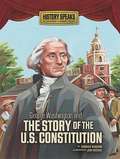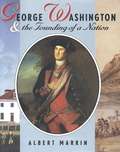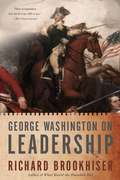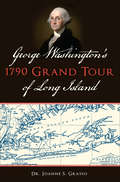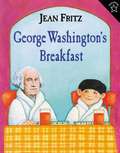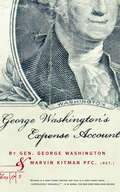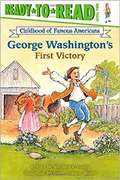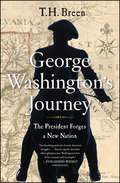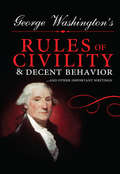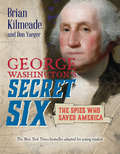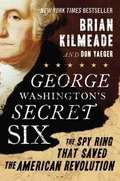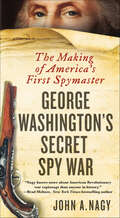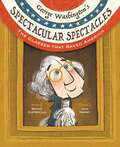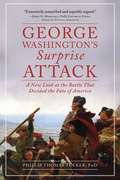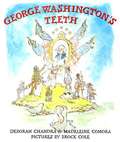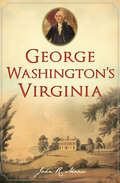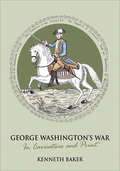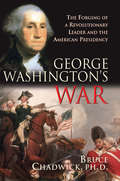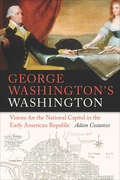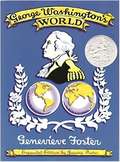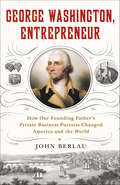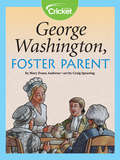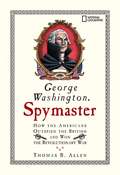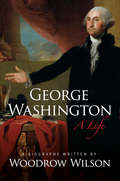- Table View
- List View
George Washington And The Story Of The U. S. Constitution
by Candice Ransom Jeni ReevesIn 1787, the newly established United States was in trouble. The central government had too little power and too little money. George Washington, Benjamin Franklin, and fifty-three other delegates gathered in Philadelphia, Pennsylvania, to find a way to solve these problems. After more than three months of work, the delegates, led by George Washington, had created the U. S. Constitution. It was finished on September 17, which is now celebrated as Constitution Day.
George Washington and the Founding of a Nation
by Albert MarrinA fascinating, fast-paced account of our first president's life and times. Albert Marrin examines the "father of our country" from the perspectives of his character, military experience, and also his slaveholding, to assess Washington's role in our history. A born leader with a commanding physique, unwavering self-discipline, and an unconquerable will to succeed, he was also-as Lord Fairfax observed when Washington was only sixteen-"a man who will go to school all his life. " Washington's schools were the rugged country of the French and Indian War, the misery-creating insolvency of the Continental Army, and the agrarian responsibility of his plantation in Mount Vernon. Neither a political theorist nor a firebrand, Washington embodied the virtues of fairness, restraint, and farsightedness that could hold the American colonies together-at least for a while. For, as he said near the end of his life and after two terms as president, "I can clearly foresee that nothing but the rooting out of slavery can perpetuate the existence of our union. "
George Washington for Kids: His Life and Times with 21 Activities (For Kids series)
by Brandon Marie MillerGeorge Washington comes alive in this fascinating activity book that introduces the leader to whom citizens turned again and again--to lead them through eight long years of war, to guide them as they wrote a new Constitution, and to act as the new nation's first executive leader. Children will learn how, shortly after his death in 1799, people began transforming George Washington from a man into a myth. But Washington was a complex individual who, like everyone, had hopes and fears, successes and failures. In his early 20s, for instance,Washington's actions helped plunge Great Britain and France into war. He later fought for liberty and independence, yet owned slaves himself (eventually freeing them in his will). This book weaves a rich tapestry of Washington's life, allowing kids to connect with his story in 21 hands-on projects based on his experiences and the times in which he lived. Children will learn how to tie a cravat, write with a quill pen, follow animal tracks, sew a lady's cap, plant a garden, roll a beeswax candle, play a game of Quoits, and make a replica of Washington's commander-in-chief flag. The text includes a time line, glossary, websites, travel resources, and a reading list for further study.
George Washington on Leadership
by Richard BrookhiserIn 1799, at the end of George Washington’s long life and illustrious career, the politician Henry Lee eulogized him as: "First in war, first in peace, and first in the hearts of his countrymen. ” Esteemed historian Richard Brookhiser now adds to this list, "First in leadership,” examining the lessons to be learned from our first president, first commander-in-chief, and founding CEO. With wit and skill, Brookhiser expertly anatomizes true leadership with lessons from Washington’s three spectacularly successful careers as an executive: general, president, and tycoon. In every area of endeavor, Washington maximized his strengths and overcame his flaws. Brookhiser shows how one man’s struggles and successes two centuries ago can serve as a model--and an inspiration--for leaders today.
George Washington's 1790 Grand Tour of Long Island
by Dr. Joanne S. GrassoThe story of the first American president’s journey through Brooklyn, Queens, Nassau, and Suffolk, based on his own diary.After being elected president, George Washington set out to tour the new nation, which was desperate for a unifying symbol. He spent five days on Long Island in April 1790, an area recovering from seven years of devastating British occupation. Washington saw it all, from Brooklyn to Patchogue to Setauket and back. He was honored at each stop and wrote extensive diary entries about his impressions of the carriage stops for food and overnight stays at taverns and private homes, as well as his vision for the future of the region. In this book, historian Dr. Joanne S. Grasso traces this momentous journey.Includes maps and illustrations
George Washington's Breakfast
by Jean FritzGeorge Washington Allen, a boy who never gives up until he finds out what he wants to know, is determined to learn all there is to know about his namesake.
George Washington's Expense Account: Gen. George Washington And Marvin Kitman, Pfc. (ret.)
by Marvin Kitman Gen. George WashingtonIn George Washington's Expense Account — the bestselling expense account in history — Kitman shows how Washington brilliantly turned his noble gesture of refusing payment for his services as commander in chief of the Continental Army into an opportunity to indulge his insatiable lust for fine food and drink, extravagant clothing, and lavish accommodations. In a close analysis of the document that financed our Revolution, Kitman uncovers more scandals than you can shake a Nixon Cabinet member at — and serves each up with verve and wit.
George Washington's First Victory (Ready-To-Read COFA)
by Stephen KrenskyDescribes an incident in the early life of George Washington, which provides a glimpse of his relationship with his mother.
George Washington's Journey
by T. H. BreenThis is George Washington in the surprising role of political strategist.T.H. Breen introduces us to a George Washington we rarely meet. During his first term as president, he decided that the only way to fulfill the Revolution was to take the new federal government directly to the people. He organized an extraordinary journey carrying him to all thirteen states. It transformed American political culture. For Washington, the stakes were high. If the nation fragmented, as it had almost done after the war, it could never become the strong, independent nation for which he had fought. In scores of communities, he communicated a powerful and enduring message--that America was now a nation, not a loose collection of states. And the people responded to his invitation in ways that he could never have predicted.s us on these journeys. We see the country through Washington's eyes and listen through his ears. We understand why George Washington is the indispensable Founding Father.
George Washington's Rules of Civility & Decent Behavior
by George Washington"Labour to keep alive in your breast that little celestial fire called conscience. ""Run not in the streets. . . nor with mouth open; go not upon the toes nor in a dancing fashion. "George Washington was known as a remarkably modest and courteous man. Humility and flawless manners were so ingrained in his character that he rarely if ever acted without them. The "Rules of Civility and Decent Behavior" that governed Washington's etiquette were by turns practical, inspirational and curious. These rules are as instructive and invaluable today as they were hundreds of years ago. George Washington's Rules of Civility and Decent Behavior includes the complete text of the rules, as well as famous Washington writings such as:-Farewell to the Armies speech-Inaugural Address-Retirement Address-Address at the End of His Presidency
George Washington's Secret Six (Young Readers Adaptation): The Spies Who Saved America
by Brian Kilmeade Don YaegerA page-turning middle-grade adaptation of the New York Times bestseller about George Washington's top-secret spy ring that helped defeat the British.The American Revolution is well under way in 1776, but things are looking bleak for General George Washington and his Continental Army. With Washington's hasty retreat from New York City in August, many think the war might soon be over. After all: how on earth is this ragtag group going to defeat its enemy, the well-trained and well-funded military of the largest empire in history? But Washington soon realizes he can't win with military might. Instead, he must outsmart the British, so he creates a sophisticated intelligence network: the top-secret Culper Spy Ring. Drawing on extensive research, Brian Kilmeade and Don Yaeger tell the fascinating stories of these long unrecognized spies: a reserved merchant, a tavern keeper, a brash young longshoreman, a curmudgeonly Long Island bachelor, a coffeehouse owner, and a mysterious woman.This vivid and accessible young readers adaptation of the New York Times bestseller features an exclusive new introduction, extensive back matter, and eye-catching art throughout. Chronicling a crucial moment in American history, this historical thriller will excite and inspire the next generation of patriots.
George Washington's Secret Six: The Spy Ring That Saved The American Revolution
by Brian Kilmeade Don Yaeger"As a Long Islander endlessly fascinated by events that happened in a place I call home, I hope with this book to give the secret six the credit they didn't get in life. The Culper spies represent all the patriotic Americans who give so much for their country but, because of the nature of their work, will not or cannot take a bow or even talk about their missions. "--Brian Kilmeade When General George Washington beat a hasty retreat from New York City in August 1776, many thought the American Revolution might soon be over. Instead, Washington rallied--thanks in large part to a little-known, top-secret group called the Culper Spy Ring. Washington realized that he couldn't beat the British with military might, so he recruited a sophisticated and deeply secretive intelligence network to infiltrate New York. So carefully guarded were the members' identities that one spy's name was not uncovered until the twentieth century, and one remains unknown today. But by now, historians have discovered enough information about the ring's activities to piece together evidence that these six individuals turned the tide of the war. Drawing on extensive research, Brian Kilmeade and Don Yaeger have painted compelling portraits of George Washington's secret six: Robert Townsend, the reserved Quaker merchant and reporter who headed the Culper Ring, keeping his identity secret even from Washington; Austin Roe, the tavern keeper who risked his employment and his life in order to protect the mission; Caleb Brewster, the brash young longshoreman who loved baiting the British and agreed to ferry messages between Connecticut and New York; Abraham Woodhull, the curmudgeonly (and surprisingly nervous) Long Island bachelor with business and family excuses for traveling to Manhattan; James Rivington, the owner of a posh coffeehouse and print shop where high-ranking British officers gossiped about secret operations; Agent 355, a woman whose identity remains unknown but who seems to have used her wit and charm to coax officers to share vital secrets. In" George Washington's Secret Six," Townsend and his fellow spies finally receive their due, taking their place among the pantheon of heroes of the American Revolution.
George Washington's Secret Spy War: The Making of America's First Spymaster
by John A. NagyThis “fast-paced chronicle reveals a little-known side of America’s Revolutionary War hero”—and how intelligence helped him defeat the British (Publishers Weekly).Here is the untold story of how George Washington used his skills as a spymaster to win the Revolutionary War. Author John A. Nagy has become the nation’s leading expert on the subject, discovering hundreds of spies who went behind enemy lines to gather intelligence during the American Revolution, many of whom are completely unknown to most historians.Drawing on Washington’s personal diaries, Nagy recounts how he honed his intelligence gathering skills during the French and Indian War. He later depended on those skills as he faced a well-trained, better-equipped fighting force in the Revolutionary War. Espionage was Washington’s secret weapon, and he exploited it to extraordinary effect.Filled with thrilling and never-before-told stories from the battlefield and behind enemy lines, this is the story of how Washington out-spied the British. For the first time, readers will discover how espionage played a major part in the American Revolution and why Washington was a master at orchestrating it.
George Washington's Spectacular Spectacles: The Glasses That Saved America
by Selene CastrovillaDid you know that George Washington had a secret? He wore glasses! While initially embarrassed by his reliance on this reading aid, Washington&’s spectacles proved to be nothing short of spectacular in this charming, funny, and little-known picture book story from American history.The Revolutionary War was over, but Washington&’s officers had not received their wages from the Continental Congress in years. Afraid they would never get their money, the officers planned to storm Congress and demand it right away. Luckily, George Washington found out about the plot just in time. He delivered a passionate speech to his men, but they were unaffected. It was only when he struggled to read aloud a letter from Congress and had to put on his glasses, that they realized how much he had sacrificed for their country along with them. The officers dropped their plan and pledged their loyalty to America and to Washington.Selene Castrovilla&’s carefully researched yet playful prose and Jenn Harney&’s energetic, original illustrations bring George Washington&’s more human side to life in this humorous but important story about true American loyalty.
George Washington's Surprise Attack: A New Look at the Battle That Decided the Fate of America
by Phillip Thomas TuckerExtensively researched and superbly argued in Tucker’s compelling narrative, this in-depth examination of George Washington’s 'military miracle’ at the Battle of Trenton unquestionably confirms the vital importance of that stunning victory.” -Jerry D. Morelock, PhD, editor in chief at Armchair GeneralLike many historical events, the American Revolution is sometimes overlooked, ignored, or minimized by historians because of common shrouding in romantic myth or interference from stubborn stereotypes. Here historian Phillip Thomas Tucker provides an in-depth look at the events of the Battle of Trenton, weeding out fiction and legend and presenting new insights and analysis. Stories from many forgotten individuals of the war, including officers and soldiers from both sides, bring to life the Continental Army’s desperate circumstances and shocking victory. Myths that Tucker debunks include the Hessians’ slovenly drunkenness, Washington acting alone in creating the attack strategy, and Rall’s incompetence as a leader largely contributing to his troops’ defeat.By exploring the forgotten aspects of one of America’s most famous battles, revealing Trenton’s story proves to be even more fascinating. In the end, America’s founding was nothing short of miraculous, and no chapter of America’s story was more miraculous than Washington’s improbable success at the battle of Trenton, where America’s fate was decided to almost everyone’s amazement on a dark, snowy morning.Skyhorse Publishing, as well as our Arcade imprint, are proud to publish a broad range of books for readers interested in history--books about World War II, the Third Reich, Hitler and his henchmen, the JFK assassination, conspiracies, the American Civil War, the American Revolution, gladiators, Vikings, ancient Rome, medieval times, the old West, and much more. While not every title we publish becomes a New York Times bestseller or a national bestseller, we are committed to books on subjects that are sometimes overlooked and to authors whose work might not otherwise find a home.
George Washington's Teeth
by Brock Cole Deborah Chandra Madeleine ComoraThe creators of George Washington's Teeth unhinge the jaws of history to examine the mouth of America's first president, tracking the poor man's dental woes as he gallops to war, crosses the Delaware, and, with only two teeth left, takes his place as leader of the country. Washington was plagued by black, rotting teeth from the time he was 22, losing about one a year until he was nearly "toofless" and had to have his first dentures made from a hippotamus tusk (that's right, not wood!). Poets Deborah Chandra and Madeleine Comora begin their quirky historical tale at a lively clip: "The Revolutionary War/ George hoped would soon be won,/ But another battle with his teeth/ Had only just begun..." Indeed. Evidently he was losing teeth even as he crossed the Delaware: "George crossed the icy Delaware/ With nine teeth in his mouth./ In that cold and pitchy dark,/ Two more teeth came out!" (Cleverly, illustrator Brock Cole mimics Emanuel Leutze's famous painting "Washington Crossing the Delaware," making Washington seem more uncomfortably tight-lipped than dignified.) The story ends happily ever after with the crafting of a nice new pair of ivory false teeth that allow George to dance around the ballroom through the night. Truth be told, however, he would be deeply troubled by his teeth until the day he died. A four-page, illustrated historic timeline of Washington's life (and mouth) completes this carefully researched, very funny, charmingly illustrated picture book that works to humanize a larger-than-life historical figure and in turn, history itself. Brilliant! (Ages 7 and older) --Karin Snelson
George Washington's Virginia (History And Guide Ser.)
by John R. MaassGeorge Washington slept, worked, and fought here . . . A historian&’s guide to Virginia sites and landmarks associated with the Founding Father. Born in the Tidewater region, George Washington was reared near Fredericksburg and took up residence at Mount Vernon along the Potomac River. As a young surveyor, he worked in Virginia&’s backcountry. He began his military career as a Virginia militia officer on the colony&’s frontier. The majority of his widespread landholdings were there—and his entrepreneurial endeavors ranged from the swamplands of the Southeast to the upper Potomac River Valley. In this book, historian John R. Maass explores the numerous sites all over the Commonwealth associated with Washington—and demonstrates their lasting importance. Includes photos and illustrations
George Washington's War: In Caricature and Print
by Kenneth BakerA Revolutionary War history told through eighteenth-century illustrations: &“Utterly absorbing&” (The Times, London). Americans are steeped in the history of the American Revolution, but often the fog of myth shrouds the reality. In these pages, the path to war is starkly documented by British caricatures of politicians and generals—for the most part favorable to the Colonists. For George III, Lord North, and Britain, the war was a disaster that need not have happened. The problems of coping with a country five thousand miles away with a tradition of representative government, a free press, and a spirit of independence were just too much. But they, together with Generals Howe, Burgoyne, Cornwallis, and others, were mercilessly lampooned. Washington, the hero, is spared, although there are surprising and dark elements to the American victory illustrated here. Using prints and caricatures from the period—some never before published—and drawing on his own experience in politics, Kenneth Baker provides vivid and memorable images that illustrate these extraordinary historical events.
George Washington's War: The Forging of a Revolutionary Leader and the American Presidency
by Bruce ChadwickDrawing on archival and other sources, Chadwick (American history, Rutgers U.) offers a new perspective on the well-known story of the plight of General Washington and his men at Valley Forge. He argues that the future president developed a model of leadership for dealing with national emergencies when he campaigned to secure emergency supplies for his troops. Includes period illustrations. Annotation ©2004 Book News, Inc., Portland, OR (booknews.com)
George Washington's Washington: Visions for the National Capital in the Early American Republic (Early American Places #1)
by Adam CostanzoThe vision, controversy and political rivalries that shaped America&’s capital are examined in this fascinating history of Washington, D.C.When America&’s first congress declared that a national capital was to be built along the Potomac, President Washington was given complete control over its design and construction. Eager to establish a federal city worthy of a powerful and rapidly expanding empire, Washington recruited commissioners, surveyors, architects, and craftsmen. But there were many—including Thomas Jefferson—who opposed Washington&’s vision for a grand American metropolis. In the fiercely partisan environment of the early republic, the construction, development, and oversight of the District of Colombia became a symbolic pawn in the contest between rival political groups. George Washington&’s Washington traces the president&’s original plan for the capital over the course of decades, through its formation, abandonment, and eventual revival in the Jacksonian era. It is not simply a history of the city during Washington&’s life but a history of his vision for the national capital and of the local and national conflicts surrounding this vision&’s acceptance and implementation.
George Washington's World
by Joanna Foster Genevieve FosterFoster's telling of the life story of George Washington does justice to the man it celebrates.
George Washington, Entrepreneur: How Our Founding Father's Private Business Pursuits Changed America and the World
by John BerlauA business biography of George Washington, focusing on his many innovations and inventions.George Washington: general, statesman...businessman? Most people don't know that Washington was one of the country's first true entrepreneurs, responsible for innovations in several industries. In George Washington, Entrepreneur, John Berlau presents a fresh, surprising take on our forefather's business pursuits.History has depicted Washington as a gifted general and political pragmatist, not an intellectual heavyweight. But he was a patron of inventors and inveterate tinkerer, and just as intelligent as Jefferson or Franklin. His library was filled with books on agriculture, history, and philosophy. He was the first to breed horses with donkeys to produce the American mule. On his estate, he grew countless varieties of trees and built a greenhouse full of exotic fruits, herbs, and plants. Unlike his Virginia neighbors who remained wedded to tobacco, Washington planted seven types of wheat. His state-of-the-art mill produced flour which he exported to Europe in sacks stamped "G. Washington"—one of the very first branded food products. Mount Vernon was also home to a distillery and became one of the largest American whiskey producers of the era.Berlau's portrait of Washington, drawn in large part from his journals and extensive correspondence, presents a side of him we haven't seen before. It is sure to delight readers of presidential biography and business history.
George Washington, Foster Parent
by Mary Evans AndrewsThe French Revolution has put George Washington's friend, the Marquis de Lafayette, in danger. Out of fear of imprisonment or execution, the Lafayettes send their son to America, to stay under Washington's protection. While in America, Georges Washington Lafayette observed democracy, features from which he eventually took back to his home country.
George Washington, Spymaster: How the Americans Outspied the British and Won the Revolutionary War
by Thomas B. AllenThe award-winning National Geographic book that presents the untold story of the invisible war behind the American Revolution. A riveting tale of intrigue, spies, counterspies and secret agents,George Washington, Spymaster is a unique and entertaining account of one of the most important chapters in our nation's history. The compelling narrative reveals the surprising role played by the first commander-in-chief, General George Washington in the War of Independence. Follow the action as 1775 dawns, and Washington finds himself in serious trouble. At war with Britain, the world's most powerful empire, his ragtag army possesses only a few muskets, some cannons, and no money. The Americans' only hope is to wage an invisible war_a war of spies, intelligence networks, and deception. Enter the shadowy world of double agents, covert operations, codes and ciphers_a world so secret that America's spymaster himself doesn't know the identities of some of his agents. Meet members of the elusive Culper Ring, uncover a "mole" in the Sons of Liberty, and see how invisible ink and even a clothesline are used to send secret messages. You can even use Washington's own secret codebook, published here for the first time. Experience at close quarters the successes and failures of the Americans as they strive to outwit the British. Meet the chief of covert operations, one Benjamin Franklin, and several other surprising players in America's secret war. Author Thomas B. Allen has sifted through dozens of historical documents and coded letters to uncover the facts about a time shrouded in secrets.
George Washington: A Life
by Woodrow WilsonA president-to-be chronicles the life and times of the historic first Chief Executive in this insightful biography. Before his entry into politics, Woodrow Wilson was a noted educator and historian, and his erudition shines in this fascinating profile of George Washington's rise to leadership. Wilson traces the iconic figure's path from his birth in a tranquil settlement through his explosive military career and precedent-setting administration, providing a fascinating portrait of colonial America along the way. "Bred a gentleman and man of honor in the free school of Virginian society," Washington came of age with the first stir of revolutionary events. His training as a surveyor made him an expert woodsman and hardy traveler, qualities that served him well during his rough apprenticeship in the French and Indian War. At the age of 44, the Revolution found him an experienced commander who organized and trained the army in addition to fighting in its battles and serving as a symbol of organized resistance. After his selfless resignation of power upon achieving victory, Washington was compelled to take on a task even harder than those of wartime: the formation of a unified national government. This edition of Wilson's scholarly yet readable biography is splendidly illustrated with portraits and maps as well as illustrations by Howard Pyle, among others, who collaborated closely with the author on depictions of episodes from Washington's extraordinary life.
